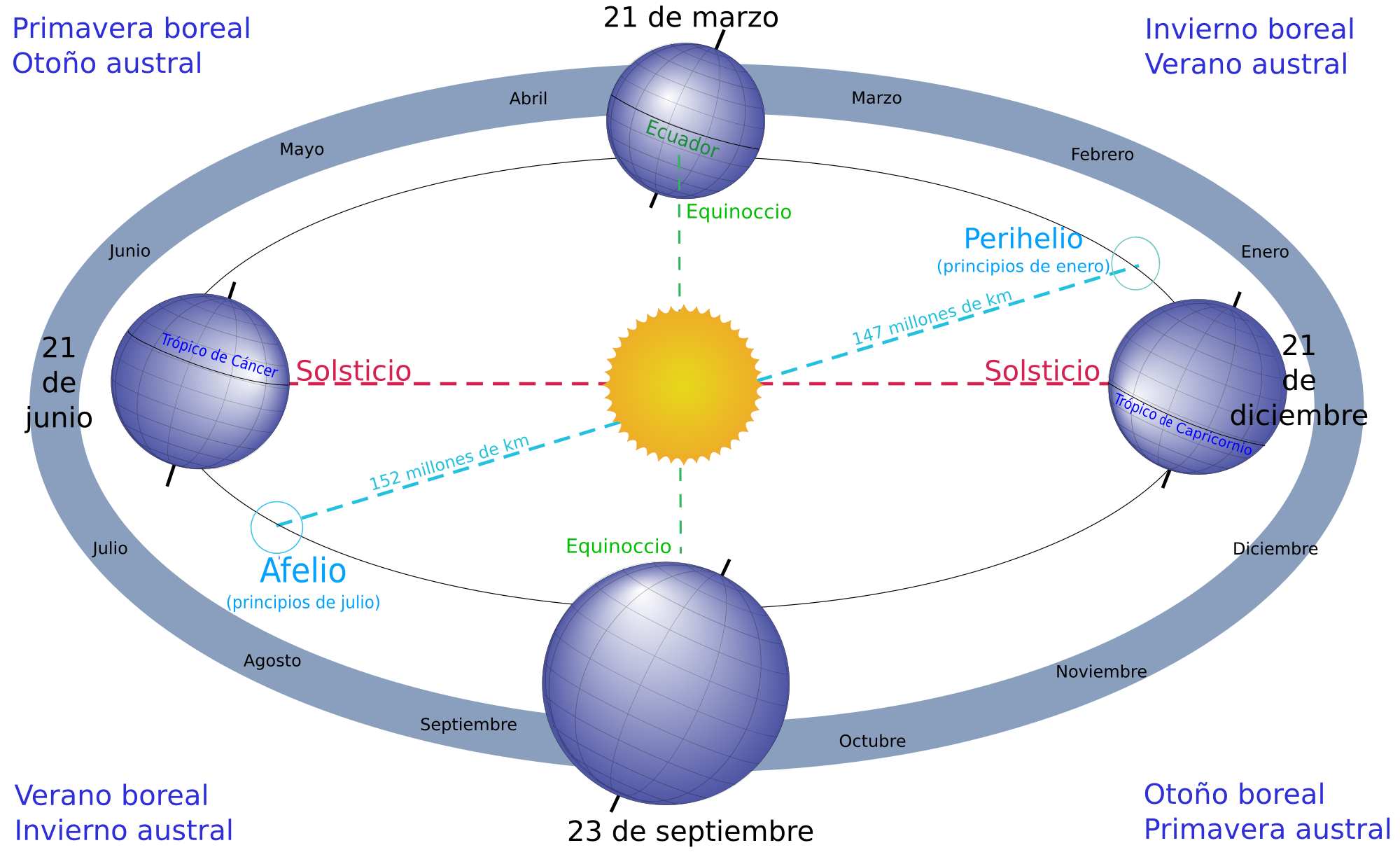5.14: En contexto: Días y meses
- Page ID
- 50128
Objetivos
- Identify months, days, and seasons
En contexto: La ciencia de las estaciones
Las cuatro estaciones del año son: primavera, verano, otoño e invierno. Durante la primavera y verano los días duran más que las noches; durante el otoño e invierno las noches son más largas que los días.
A causa de la inclinación del eje de rotación de la tierra, estos fenómenos no se producen al mismo tiempo en los dos hemisferios, sino que están invertidos el uno con relación al otro. Cuando en un hemisferio es invierno, en el otro es verano. Cuando es en uno es primavera, en el otro es otoño.

Debido a la inclinación del eje terrestre, el Sol llega a su altura máxima en el invierno en el hemisferio norte a 23.4° por debajo del Ecuador y en el verano alcanza la misma, pero encima del Ecuador. Estos dos días de altura máxima se llaman solsticios y ocurren el 20 o 21 de junio y el 21 o 22 de diciembre. Al principio de la primavera y al principio del otoño, el Sol está en el ecuador. En estas dos fechas los días y las noches son iguales, y el 20 de marzo y el 22 o 23 de septiembre se llaman equinoccios. Debido a este movimiento el Sol llega cada día a una altura diferente sobre el horizonte, y el día dura menos de doce horas durante medio año, y más de doce horas durante el resto. Sólo en el ecuador terrestre los días y las noches son siempre de doce horas.
An audio element has been excluded from this version of the text. You can listen to it online here: http://pb.libretexts.org/introductoryspanishii/?p=154
Preguntas
https://assessments.lumenlearning.co...essments/13747
[reveal-answer q=”639987″]Text-only version of questions[/reveal-answer]
[hidden-answer a=”639987″]
- In the upper-left quadrant of the image, we see the months abril , mayo , and junio . The quadrant is labeled Primavera boreal / Otoño austral. Based on these months and assuming you’re in the Northern Hemisphere, what do you think primavera means?
- Spring
- Summer
- Fall
- Winter
- In terms of geography, boreal refers to the northern hemisphere and austral to the south. Based on this diagram, what season is it in the southern hemisphere when it’s invierno in the north?
- verano
- invierno
- primavera
- otoño
- In the northern hemisphere, which of the following months does not belong in verano ?
- diciembre
- agosto
- julio
- septiembre
- In the northern hemisphere, which of the following months does not belong in invierno ?
- abril
- febrero
- enero
- diciembre
-
En el norte en junio…
- Los días duran más que las noches.
- Las noches son más largas que los días.
- Los días y las noches son iguales.
-
En el 20/21 de marzo (el equinoccio)….
- Los días y las noches son iguales.
- Los días duran más que las noches.
- Las noches son más largas que los días.
-
¿Cuánto dura un día en el ecuador?
- doce horas
- veinte horas
- dos horas
- diez horas
[/hidden-answer]
Contribute!
- Beginner Spanish OER. Provided by: Athabasca University. Located at: https://ocw.lms.athabascau.ca/mod/page/view.php?id=3176&forceview=1. License: CC BY-SA: Attribution-ShareAlike
- Estaciones del au00f1o. Authored by: Horst Frank, Gothika, modified by El duende alegre.. Located at: https://commons.wikimedia.org/wiki/File:Estaciones_del_a%C3%B1o.png. License: CC BY-SA: Attribution-ShareAlike

